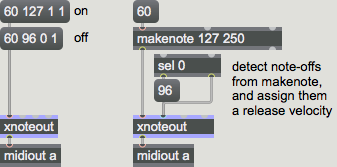xnoteout
Examples

Arguments
channel [int]
Sets an initial value for the MIDI channel of the outgoing messages. Channel numbers greater than 16 will be wrapped around to stay within the 1-16 range. If there is no argument, the initial channel number is .
Attributes
Common Box Attributes
annotation [symbol]
Sets the text that will be displayed in the Clue window when the user moves the mouse over the object.
background [int] (default: 0)
Adds or removes the object from the patcher's background layer. adds the object to the background layer, removes it. Objects in the background layer are shown behind all objects in the default foreground layer.
color [4 floats]
Sets the color for the object box outline.
fontface [int]
Sets the type style used by the object. The options are:
plain
bold
italic
bold italic
Possible values:
0 = 'regular'
1 = 'bold'
2 = 'italic'
3 = 'bold italic'
fontname [symbol]
Sets the object's font.
fontsize [float]
Sets the object's font size (in points).
Possible values:
'8'
'9'
'10'
'11'
'12'
'13'
'14'
'16'
'18'
'20'
'24'
'30'
'36'
'48'
'64'
'72'
hidden [int] (default: 0)
Toggles whether an object is hidden when the patcher is locked.
hint [symbol]
Sets the text that will be displayed in as a pop-up hint when the user moves the mouse over the object in a locked patcher.
ignoreclick [int] (default: 0)
Toggles whether an object ignores mouse clicks in a locked patcher.
jspainterfile [symbol]
JS Painter File
patching_rect [4 floats] (default: 0. 0. 100. 0.)
Sets the position and size of the object in the patcher window.
position [2 floats]
Sets the object's x and y position in both patching and presentation modes (if the object belongs to its patcher's presentation), leaving its size unchanged.
presentation [int] (default: 0)
Sets whether an object belongs to the patcher's presentation.
presentation_rect [4 floats] (default: 0. 0. 0. 0.)
Sets the x and y position and width and height of the object in the patcher's presentation, leaving its patching position unchanged.
rect [4 floats]
Sets the x and y position and width and height of the object in both patching and presentation modes (if the object belongs to its patcher's presentation).
size [2 floats]
Sets the object's width and height in both patching and presentation modes (if the object belongs to its patcher's presentation), leaving its position unchanged.
textcolor [4 floats]
Sets the color for the object's text in RGBA format.
textjustification [int]
Sets the justification for the object's text.
Possible values:
0 = 'left'
1 = 'center'
2 = 'right'
varname [symbol]
Sets the patcher's scripting name, which can be used to address the object by name in pattr, scripting messages to thispatcher, and the js object.
Messages
bang
int
Arguments
In left-middle inlet: The number is stored as the velocity for either a note-on or a note-off message. If no number has been received yet, the velocity for note-ons is , and the velocity for note-offs is .
In right-middle inlet: The number is stored as the indicator of whether outgoing messages should be note-ons or note-offs. If the number is not 0, xnoteout will send out a note-on message. If the number is , xnoteout will send out a note-off message with a release velocity. If no number has been received yet, it is initially (note-on).
In right inlet: The number is stored as the channel for the MIDI message sent out by xnoteout. Channel numbers greater than 16 will be wrapped around to stay within the 1-16 range.
(inlet1)
Arguments
(inlet2)
Arguments
(inlet3)
Arguments
list
Arguments
velocity [int]
note-flag [int]
channel [int]
Output
int
When a pitch value is received, a complete MIDI note-on or note-off message is sent out the outlet, byte-by-byte. Whereas a note-on with a velocity of 0 is most commonly used to indicate a note-off, xnoteout sends out the MIDI note-off command and uses the specified velocity as a release velocity.
See Also
| Name | Description |
|---|---|
| MIDI | MIDI |
| noteout | Transmit MIDI note messages |
| midiout | Transmit raw MIDI data |
| xnotein | Interpret MIDI note messages with release velocity |